
Remember the evil Queen in ‘Snow White’, who used to stand in front of her mirror and ask this question? Dreading the answer, in case she was not deemed the ‘fairest’ (which, in the fairy tale, meant ‘the most beautiful’)?
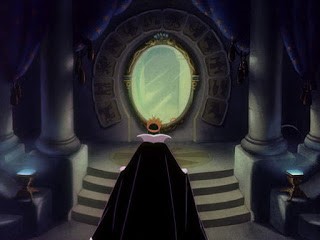
Who’s the fairest of us all? Image courtesy disneyscreencaps.com
As people with dark skin, Sri Lankans face a challenge which many of us are reluctant to recognise: that ‘white’ is seen as ‘privileged’ and that not being ‘white’ or ‘fair’ is consequently seen as an inferior status.
And we see this projected onto us every day.
Many of the messages we absorb about our value and our worth come from the advertisements we see in magazines, on television, at the movies, and other media. The eye-opening part of this is that we in South Asia, who endorse these advertisements, are perpetuating racist stereotypes and imposing implied inferiority onto ourselves and our fellow citizens. By buying into and creating this type of marketing, we accept an inferior status in the contemporary world, in which fairer-skinned people are seen as an ideal, and darker skinned are seen as comparatively lesser.
How Did This Happen?
Manisha Anjali, a poet and writer who has written extensively on the subject of skin bleaching, comments that: “South Asia is in desperate need of a skin-positivity revolution. White worship is an archaic colonial hangover.”
One of the advantages of living in the 21st Century is that we can evaluate the cultural myths that have been imposed on us: see how they started, see through them, and set them aside, if they are damaging and belittling to us.
The greatest cultural myth underlying colonialism is that of the inherent superiority of the coloniser. White superiority was expressed aggressively, through genocide, exploitation, humiliation, and pervasive cruelty towards those of darker race, who inhabited lands rich in resources which were coveted by the colonisers. The ‘Terra Nullius’ doctrine in Australia declared the land on which dark-skinned indigenous people were living to be ‘uninhabited’, and thus available to be ‘settled’ and ‘developed’.
But the association of ‘darker’ with something lesser, something less formed, more violent, goes back to far more primitive times. Think about the common expressions: ‘Dark and Difficult Days’, ‘The Dark Lord’ (from the Harry Potter series), ‘On a Dark Night, There Came A Dark Man With A Dark Purpose’ (from ‘Aladdin’), ‘The Darkest Hour Is Just Before The Dawn’, ‘The Heart of Darkness’ and ‘The Dark Ages’. Humans fear the darkness of the night, which could be filled with unseen horrors, and this fear is evident in the way we are threatened by the dark, and have to contain it, control it, and protect ourselves against it.
This impacts on what we hear, when a 7-year-old is asked what colour the bath water is after her bath. Does her skin colour wash off? So that if she is cleaned up, she will look acceptable? And why is what is acceptable, fairer?
This may seem relatively harmless at first hearing, as children are too young to know what they are talking about. But children grow up into adults, and carry their unquestioned beliefs with them. And some of them become copywriters for advertising agencies.
A typical example of how beliefs of white superiority are perpetuated is the targeting of high-end, luxury buyers through images associating white-skinned people with unquestioned dominance and power.
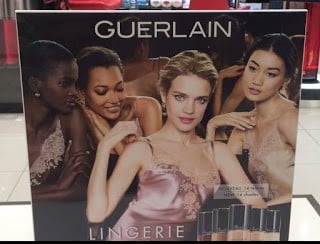
Beauty standards: the whiter the better.
Note how the dominant figure in the above advertisement is a white woman, centred and positioned with her gaze directed at the viewer, conveying strength and power. See how the darker hued women around her have their gazes averted from the viewer, or deferentially directed at the woman in the central position. The African, East Asian, and South Asian women are visually portrayed as occupying less powerful space in this portrait, and as relegated to ‘minority’, and literally marginalised, status.
This experience of marginalisation is something that we notice when we emigrate to places like the U.K., Europe, the United States, Canada, New Zealand, or Australia. In these countries, dark-skinned people are seen as a minority group, and our skin colour makes us visibly different from the Anglo-Celtic majority in these societies. We should be aware that countries like North America, Canada, and Australia are all societies created on the genocide of their indigenous populations, who resemble us. And the immigrants who were accepted into these countries often formed an underclass, whose members are frequently physically similar in feature and skin colour to us.

Environmental factors play a major role in determining skin colour.
People who judge books by their covers also judge immigrants by their colour.
As immigrants, if we are fortunate, we have people commenting on how ‘luscious’ we look, with our big, dark eyes and lustrous dark hair. If we are unfortunate, we might be viewed by redneck racists as bush pigs, or pieces of exotica. People show conflicted feelings towards our skin colour, and as human beings are responsive creatures, we absorb this conflictedness.
Colour Aspirations
What we aspire to be seen with, and seen to have, tells us a lot about ourselves. What colour are our dreams? We fetishise and make icons out of what we wish to be, and have. The size and location of our house. The friends we associate with. The clothes and accessories we acquire. The books we read, the events we attend. The food we conspicuously consume. What we look like. What colour are WE, in our dreams?
There are two great ironies that are observable about this:
1 Many white-skinned people try, through sun tanning in salons and on the beach, applying sun lotions, and using sun beds, to become brown. They risk skin cancer to achieve the colour we are naturally born with. In countries with wretched wintry climates, a tan signifies the ability to travel to Spain or the Mediterranean, or to own a summer home, and thus denotes further privilege.
2 We brown-skinned individuals, in contrast, are surrounded by images and advertising in our own countries which shame us for our darker hue. Skin whitening and bleaching products abound, and we are told that darker shades of skin tone are ‘blemishes’, and ‘unsightly’. Marriage advertisements specify fairer complexions as being the most preferred by potential husbands and wives, and their extended families, and women and girls in particular from a young age are praised for their relative fairness or criticised for their relatively dark skin.

The panoramic preference for fair skin, as shown in a recent ‘marriage proposals’ section of a popular Sri Lankan Sunday newspaper.
The condition of being ‘fair’ is seen as the attainment of the state of perfection worth striving for, and by implication, darker skinned people are seen as wanting, missing things that they need, and desiring things that they have missed out on having.
Fair complexions have been associated with privilege and higher socio-economic status for centuries, probably since those fortunate individuals who did not have to work in the fields under a blazing sun to earn their living were able to protect their complexions from harsh extremes of climate and weather. Thus, radiant, fair, soft skin has become a desirable asset to have, and to display: an indication of one’s ‘worth’ and ‘value’.
However, in the modern world, while many white women and men are endangering themselves trying to become brown, brown women and some men ‒ even international film stars! ‒ are endorsing products which promote skin-whitening. We are all apparently dying to look more like each other!
The images presented to us of physical flawlessness via global advertising show generically airbrushed people with smooth alabaster skin. Only recently have golden brown or dark chocolate or coffee coloured people been celebrated as beautiful. Supermodel Iman objected strongly to someone saying that she was like a “white woman dipped in chocolate,” because the ‘compliment’ implied that she was beautiful because her features were acceptable to the white normative model of beauty, as if her colour was like a topping on a dessert, or an accessory to an outfit, and not part of her inherent self. In fact, the ‘compliment’ implied that she was beautiful because her ‘inner whiteness’ shone through her dark skin ‒ no wonder she was offended!
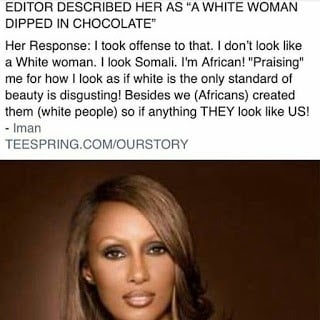
Supermodel Iman’s response to being told she looked ‘like a white woman dipped in chocolate’.
What Are The Biological Facts?
Dark skin merely means that the skin has a greater degree of Melanin. Along with this comes inbuilt skin protection from the sun, via a degree of subcutaneous oil which keeps us looking relatively young. While white skinned people develop freckles, creases, skin cancers, and dry skin, and constantly try to ‘nourish’ their skin with external emollients, dark skinned people age comparatively more attractively.
With our darker skin comes some physical negatives, however. Acanthosis Nigricans causes thickening of the skin and dark patches to appear on the body and face. And when we are wounded, or recovering from surgery, our scars can be thicker and darker, due to Keloid reaction. Both of these are conditions which those of us with darker skin are more prone to experience.
What Are The Historical Facts?
We all know that colonisation took place in history. But that does not mean its impact has ended. It was based on racist assumptions of cultural superiority and inferiority, and in our contemporary world these attitudes are inflamed by immigration, refugee migration, and huge cultural backlashes that we are witnessing against multiculturalism in countries like the U.S., the U.K., and Australia. A recent poll showed that almost 50% of people living in Australia actively objected to immigration from countries in which people were seen as visually different from themselves. In post-Brexit Britain, there are pro-nationalist policies being implemented which designate and define ‘British’ individuals, seeking to differentiate ‘essentially’ British people from those who are merely living in Britain to improve their economic conditions by earning their living in British currency. How far will these categories extend? Who will be included? Who will be excluded?
Colour-coded targeting and profiling of people has historical connotations which are racist, and unsettling. The Nazis during the Holocaust forced their prisoners to wear colour-coded signs on their clothes: Yellow Stars for Jews, Pink Triangles For Homosexuals, etc. Being called a ‘Chocolate Drop’ at school is not at the same level, but it is on the spectrum of otherisation. Our skin and its colour is a visual designator: an imprint that cannot be bleached or scrubbed off.
What should change is not the skin colour of people, but the social and cultural attitudes that shame people for inhabiting their own bodies.
Why Is Colour-Shaming Happening Today?
There is currently a narrowing of borders, a narrowing of minds, and a diminishing of generosity which can be seen all over the world, in every country where there is an immigrant population. This is part of a backlash against policies of multiculturalism which in recent times are being blamed for many of the social and economic ills besetting Western countries.
The most obvious differences between people are physical: in our body shape and size, our facial features, our clothing and the colour of our skin. This is why being dark and large-sized is often seen as a double negative, in contemporary society, which along with its other superficial attitudes, constructs our physical attributes as ‘assets’ or ‘liabilities’. Plus-size positivism is one way of responding to this. So is dark skin positivism.
Underlying racism often comes out into the open when privileged territory is disputed, by dark-skinned and talented people. Let us note the way the Obama family have been attacked since Barack Obama became the first black U.S. President, 8 years ago. Michelle Obama has been called a ‘gorilla‘, and her elder daughter a ‘monkey’ ‒ because they were boldly entering into and legitimately inhabiting the whitest of white spaces: The White House. And Harvard University.
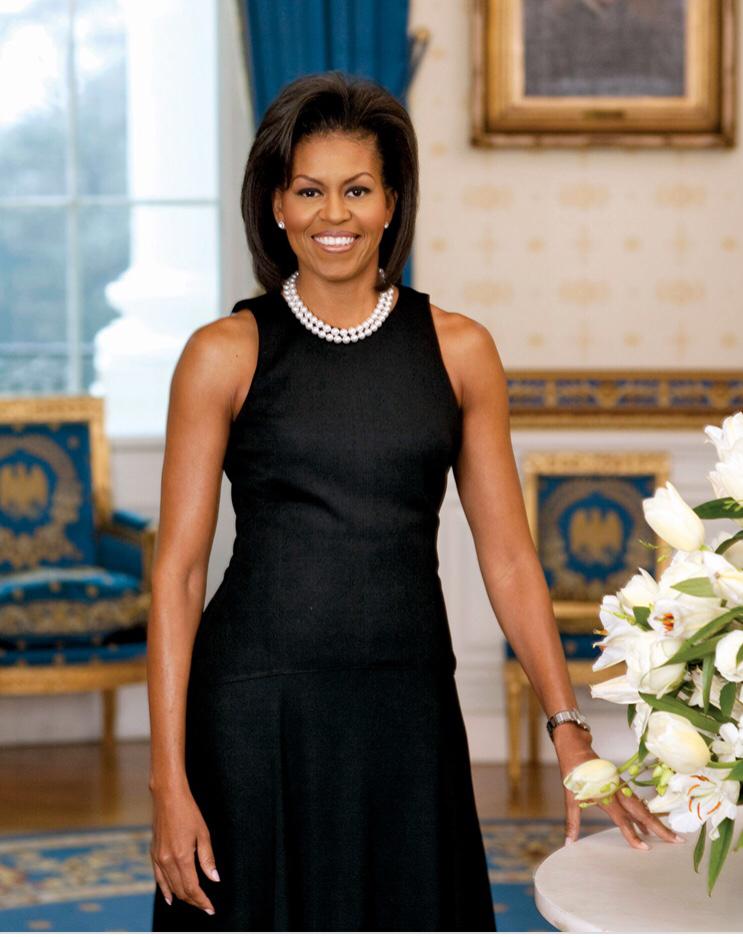
Michelle Obama, occupying the whitest of white spaces. Photo credit: Annie Leibovitz for Vogue
What Is The Impact Of This Imprinted Inferiority?
The association of dark skin with ‘lesser’ or culturally despised status is intensified because it derives its impact from a number of concurrent and co-existing factors, which operate simultaneously on those they impact upon. And this message is strongly imprinted on us from a very young age:
When we see the young children in the video above aligning themselves with the doll who is ‘ugly’, ‘not pretty’, ‘bad’, and ‘not nice’; and not to the white doll, whose white skin they associate with ‘niceness’ and ‘prettiness’, we can understand how we internalise ideas about our status from a young age, and how difficult it will be to challenge external racism and other inequities which makes us feel lesser, when we already carry those terrible feelings inside ourselves, with a self-concept damaged by the inequities of the society in which we live.
We are all aware that high-end designer labels in South Asia are routinely sold to us using fair-skinned models. These images of people who do not look like us, continually and subconsciously impact on us, excluding us from identifying with the luxury and glamour, the wealth and success these beautiful people, and the lifestyles they are associated with, create in our minds.
It is historical fact that those of darker skin have been objectified, vilified, enslaved, targeted, sexualised, colonised, exploited, harassed, incarcerated, abused, and denigrated by dominant white culture ‒ and those who perpetuate the dogma of white racial superiority ‒ for centuries. Thus, being born dark-skinned in a racist world immediately places us in a problematic relationship to the natural need and wish for self-worth and self-fulfillment that is inherent in all human beings. Dark skin colour is socio-culturally associated with a problematic life.
Conflicted Visions Of Beauty
Exoticisation and eroticisation are yet another form of targeting. Dark-skinned people are often presented as more sexualised and sexually available than other races. So perhaps we should think twice when we are called ‘hot’ because of our honey-hued skin and curvy bodies. We could also be being designated as more alluring, and provocative ‒ and the attention we receive may quickly become disrespectful and unwanted. People project fantasies onto dark-skinned, ‘exotic’ people all the time. As they do to ‘exotic’ locations.
Dark = ‘Dirty’
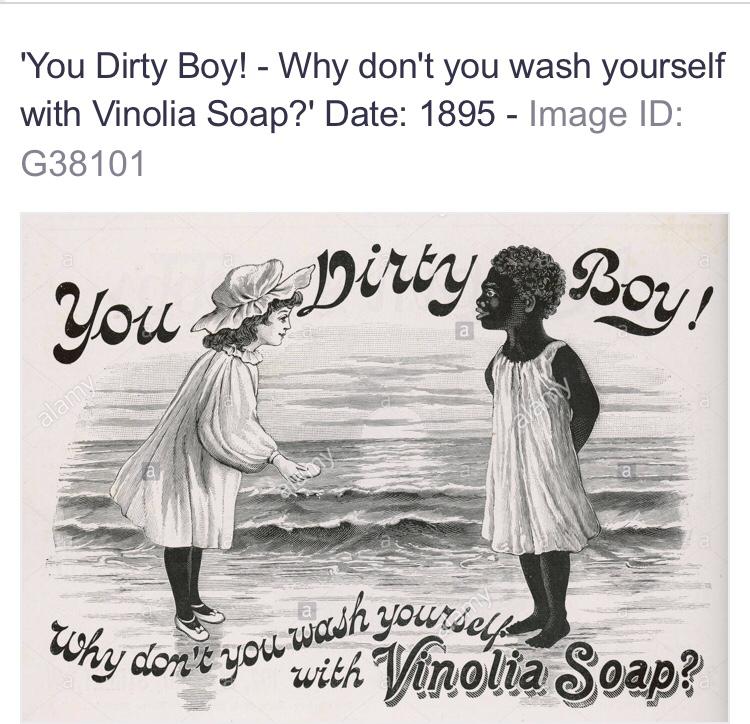
This picture speaks a 100,000 words – all of them offensive. Image courtesy waitbutwhy.com
These negative associations have powerful effects on us. However strong our self-esteem is, we are implicitly told that to be beautiful, we must not only exfoliate but also decontaminate ourselves from whatever causes us to be diseased with a dark hue. Beauty rituals at spas all over the country emphasise the whitening ‘benefits’ their products offer. Come into the salon stressed, distressed, discoloured, weighed down (by the problems of the third world) ‒ and leave uplifted, purified and ‘lightened up’. Your aura and your skin will be radiant and glowing! Your ‘defects’ will be diminished! You will emerge several shades lighter, from the wrapping and peeling and bleaching and scraping and face masks and face peels, and all the absolving effects these are guaranteed to have on us.
The products sold to us to ‘remedy’ our dark skin are saturated with chemicals. Their physical impact on us becomes even more dangerous when we are effectively told we should be ashamed of ourselves, in advertisements which attempt to sell us skin whitening creams to lighten the colour of our private parts, because sexual shaming is deliberately brought into the wording of the advertisements as well, disguised as helpful advice, to make the buyer more ‘appealing’ and ‘desirable’.
How Shaming Looks And Sounds
Human beings seem very good at shaming each other, particularly where our physicality and sexuality are concerned. They often treat it as a joking matter. Take a look at the following text, which was posted up as a humorous item on Facebook recently. By a woman.

Found on social media.
Our private body parts are not inherently ‘dirty’ or shameful. Yet, because they are clothed and covered most of the time, they are associated with aspects of ourselves that we feel are private and should be protected from public gaze, and so are not exposed to air and sun as much as the rest of our body. In freer societies, less constricting or covering clothing leads to better circulation and less ‘unevenness of skin tone’.
Listen to the euphemisms used by advertisers, in the interests both of political correctness and expansion of a client base. Look at the implications of the image below, which is supposedly skin positive and inclusive of diversity. Note that at the end of the spectrum is burnt toast, which is inedible (and carcinogenic).
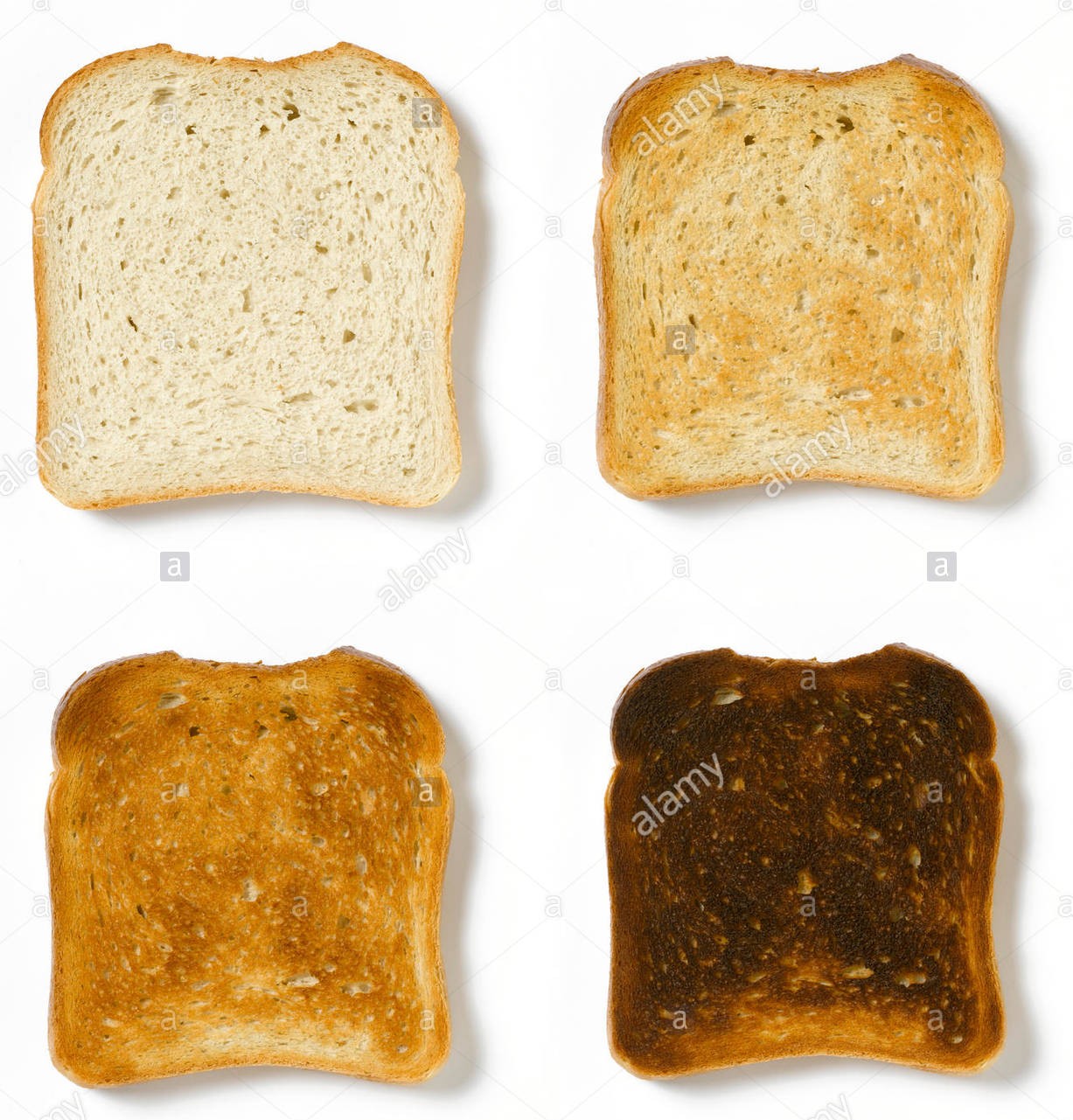
This image is often seen as a positive expression of colour diversity. Image courtesy Pinterest
The private parts and sexual organs of most human beings are naturally darker than the rest of our bodies. Where white skinned people have pinkish parts, we have brown or dark brown parts. This is surely nothing to be ashamed of ‒ in fact, it is part of the diversity of the human race!
However, when you add the shame we are culturally taught to feel about our sexuality to shame about the ‘discolouration’ of our private parts, we get a powerful, product-selling message ‒ which people buy, along with the products that these messages sell to them. But really, this shaming needs to stop. We are not inserted into our skin: we are embodied within our skin. We must surely learn to accept and embrace our embodiment, or be separated all our lives from our inner sense of dignity and self-respect.
Many of our beliefs about ourselves begin in the comments made about us from when we are young, by various well-intentioned (or ill-intentioned) family members.
Manisha Anjali has showcased this in her poetic work ‘Sun God White Face’, which “was composed when [she] was approached by editor Michalia Arathimos to contribute to a special issue of Blackmail Press named ‘Piercing The White Space’”.
Where Colour Shaming Starts And How It Can Be Challenged
It starts in the home. And it is perpetuated in the comments we make about each other, and the way we speak to each other, at work and at social functions. When we praise each other for looking ‘prettyyy’ or ‘so fair’ as if they are concepts that are interchangeable. When our elders tell us we look so fair that we ‘could be European’, as if that was a compliment! To ‘pass for’ being white! When such a high percentage of marriage advertisements rate fairness, literally, as a desirable quality.
It is not just personal. It is also political. Martin Luther King’s famous ‘I Have A Dream’ speech can be summed up by one telling phrase: he wanted his children to grow up in a world where they would be ‘judged not by the colour of their skin, but by the content of their character’.
We need to start re-thinking how we give and accept praise, when it comes to our skin colour, and our appearance in general. We can consciously praise qualities of character rather than physical features. We can omit offering each other ‘complimentary’ comments about each other’s complexions. We can choose a less superficial and less damaging way of relating to each other.
We achieved Independence as a nation 60 years ago. It is surely time we made ourselves free of this internalised and self-imposed prejudice, as well. Unless we actually believe it ourselves, any racist assumption of our inferiority as dark-skinned people need only go skin deep.
Featured image courtesy youthkiawaaz.com







